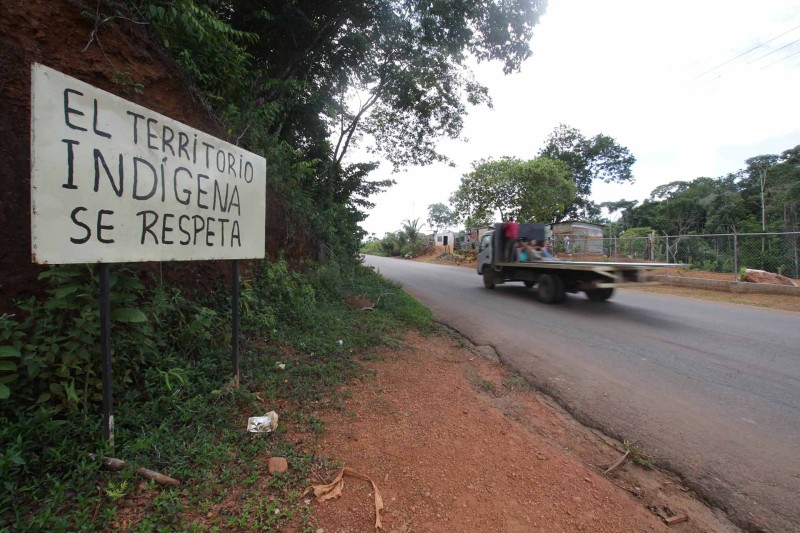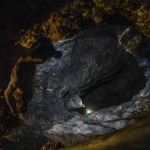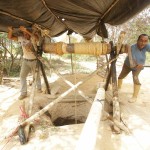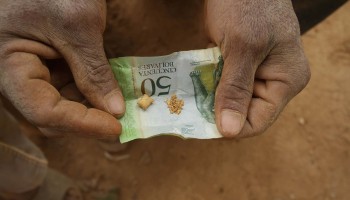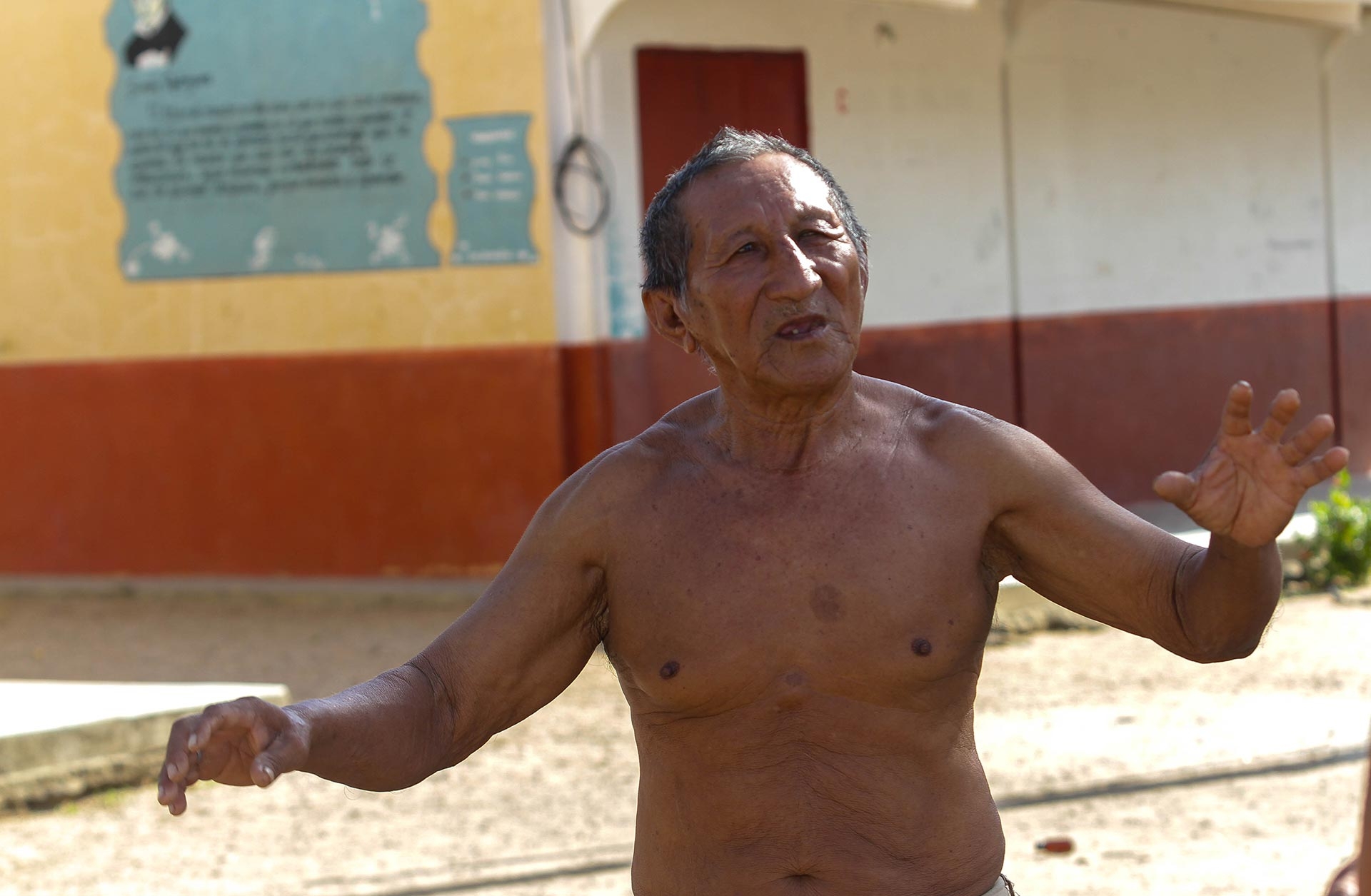With little warning last November, a company started to build a gold-processing plant in Venezuela’s Bolivar state -- home to many tribal people and an area called Las Brisas-Las Cristinas, believed to contain the country’s largest gold deposits.
Pasiano Elliman, a leader of the Pemon tribe, said his people reacted immediately. “We demanded to talk with the person in charge and told him that his workers couldn’t do anything in our territory without the approval of the community’s legitimate authorities,” he told OCCRP reporters.
“Since they didn’t listen, the next day we returned with the support of all eight native communities in San Isidro. We took our bows and arrows, we showed them our unity and strength. That’s when they shut down the works.”
But while the Pemon people may have won a battle, the war over resource exploitation continues across the Orinoco Mining Arc, an area about the size of Bulgaria or the US state of Virginia that is believed to contain mineral resources worth billions of dollars.
The stakes for both sides are tremendous. The government -- which is desperate to add new revenue streams to Venezuela’s shrinking economy -- has authorized four companies to exploit the area, with more to come.
But critics say few of the companies seem to have the requisite experience, and those that have begun to work have faced resistance. Meanwhile, activists say that environmental protections are being ignored and the rights of native people trampled.
Elliman says this skirmish is just the beginning. “Our priority is the fight for our lands,” he says. “All of this area, including Las Brisas-Las Cristinas, belongs to us.”
Thinking big and moving fast
When global oil prices fell after the 2008 financial crisis, Venezuela’s then-President Hugo Chávez saw an opportunity to implement one of his signature big ideas and turn his country’s economy in a new direction. Oil, after all, accounted for 95 percent of its exports and a large share of its gross domestic product. Venezuela’s economy needed something new.
Chávez proposed turning to other minerals believed to lie beneath the country’s jungles, including gold, diamonds, and a metallic ore called columbite-tantalum, or coltan for short. Coltan, which is refined into the metal tantalum and used to manufacture electronic devices like mobile phones, gaming equipment and advanced weaponry, doubled and tripled in value around 2011 before dropping this year to more usual historic levels.
Chávez claimed that coltan worth billions of dollars, as well as other valuable rare earths, might lie beneath a huge crescent of land along Venezuela’s Orinoco River that became known as the Mining Arc.
“Coltan has prices in the international market superior to gold and diamond,” he said in 2010. “The [coltan] reserves in Venezuela could, in a very preliminary evaluation, approach $100 billion.”
But the state of Bolivar is also home to two national parks and a population of 1.4 million, many of whom belong to native tribes whose rights to the land are enshrined in the Venezuelan constitution.
Look before you leap, expert warns
Geological engineer Noel Mariño, who has conducted extensive studies of the issue, believes that Chávez may have painted too rosy a picture of the potential mining riches, particularly as regards coltan.
He says the true amount, quality, and even location of the ore remains unknown.
“There has been no serious prospecting, and exploration and exploitation initiatives have been undertaken blindly, without addressing all technical, environmental and economic variables,” he says. “Companies that are venturing into the Orinoco Mining Arc looking for coltan will have to start from scratch.”
Mariño has spent decades honing his expertise in mineral extraction. With support from Venezuela’s National Institute of Geology and Mining, he has studied the coltan deposits in the Parguaza area of Cedeño municipality, near the country’s western border with Colombia.
He also worked for almost 25 years in CVG Bauxilum, the state-owned bauxite and aluminum producer.
Mariño notes several important factors that will determine whether Venezuela can make significant money from coltan, including how rich the ore is, where it is, and what type of technology is needed to extract it. He says this implies huge, long-term investments that the state cannot finance alone.
New-minted companies win speedy access
Despite these problems, the Orinoco Mining Arc project is moving forward. After its announcement by Chávez, the plans languished for five years, until they were picked up again in early 2016 by the former president’s successor, Nicolás Maduro.
Just a few months later, the companies were ready for action.
On Aug. 5, 2016, Faoz Corporation Ltd. became the first company to sign up for a slice of the Orinoco Mining Arc. Its agreement with the government followed a “mixed-company” model, in which the state retains majority control. Other companies, such as Supracal Ltd., soon followed suit.
By April, when OCCRP reporters were visiting the area, Faoz was the only company to have a visible presence in the 111,183-square-kilometer crescent stretching south of the Orinoco River. The Faoz operation is in the Parguaza sector, Cedeño municipality, Bolívar state, at the western end of the mining arc near the border with Colombia. Traditionally a gold-mining area, it is believed to also contain deposits of coltan ore.
Faoz was created on July 29, 2016, just seven days before signing the deal with the government. It has no known experience in mining or handling coltan, and is represented by Luisa Herminia Alcalá Otero, then 67, who had previously worked for the state-owned PDVSA oil and gas company.
On Aug. 5, Alcalá signed an agreement with then-Environmental Mining Development Minister Roberto Mirabal to create the Parguaza Ecosocialist Mixed Mining Company Inc., a joint venture between the state and Faoz, to extract coltan and other minerals, including cassiterite, ilmenite, tin, zircons, diamonds, and gold.
The minerals lie beneath the Guiana Highlands, one of the oldest geological formations on earth. The area includes part of the Amazon forest, sometimes called “the lung of the world,” as well as the ancestral homeland of native peoples and communities. Questions of environmental sustainability and respect for cultural diversity have helped fuel a heated debate over the Orinoco Mining Arc, both in Venezuela and abroad.
Venezuelan law specifies that mining activities must be preceded by environmental and socio-cultural impact studies. None have been completed for any of the planned Orinoco Mining Arc projects. Consequently, the human rights organizations Provea and Laboratorio de Paz, as well as the Los Andes University’s Work Group on Native Affairs, have demanded that the government obey the law.
On Dec. 2, 2016, the government promised to do so at a hearing before the Inter-American Commission on Human Rights in Panama. “There are plans to carry out the environmental studies demanded by the Constitution and the law before starting operations,” said Larry Davoe, a member of the Venezuela delegation.
Yet just a week later, on Dec. 9, Parguaza began operations at its first mining camp, without the required studies.
The Venezuelan government hasn’t explained how it decides which national or foreign companies are chosen to mine in Bolívar state. When relaunching the Orinoco Mining Arc project in February, President Maduro announced that 150 companies were interested in pursuing mining exploration and exploitation projects.
But so far, few have done so. Since August 2016, 14 companies have signed agreements to move forward. The Venezuelan companies include Faoz Corporation, Ecomine, Supracal, Hidrocal and the state-owned Military Corporation of Mining, Oil and Gas Industries (Camimpeg, for its initials in Spanish.) The foreign companies are Gold Reserve, Energold Mineral, Guaniamo Mining, Barrick Gold, Bedeschi, MPE International, Afridiam, Yakuang Group, and Camc Engineering Co.
Since January 2017, little information has been released about ongoing talks between the government and South Africa regarding additional mixed companies, or about MOUs for exploration activities with two Venezuelan companies headed by Palestinian businessmen: Sakan Ltd. and Comercializadora Orinoco River.
So far, four mixed companies have been formally created, assigned to areas and authorized to start operations: Parguaza, Oro Azul and Metales del Sur in Cedeño municipality; and Siembra Minera, in Sifontes municipality.
Only Parguaza is known to have started work, in December of 2016 -- and it has met with determined opposition.
A Split in the Piaroa Community
One of the company’s camps lies in the Aguamena sector on Venezuela’s western border with Colombia, along Route 12, which connects Bolívar City with Puerto Ayacucho. Four large trailers serve as both offices and bedrooms, with two smaller ones for the kitchen and storage.
Security is provided by two National Guardsmen stationed at the entrance and a security guard equipped with a communications radio. When OCCRP reporters arrived on April 5, 2017, all three were taking refuge from the noonday sun in the shade of a parked bus.
The base of operations, located about 10 kilometers from the Tierra Blanca community of Piaroa tribespeople, occupies approximately five hectares. The actual work of prospecting for coltan is carried out in even more restricted areas.
Strangers are barred from entering the camp, although local Piaroa leaders can come and go as they please. Josué Mendoza, who represents Piaroa chief Enrique Gordons, accompanied reporters to the site.
Mendoza is an enthusiastic supporter of the government’s mining development plans.
He says all 16 native tribes in the Orinoco territory’s 198 communities support the government: Piaroa, Mapoyo, Pemon, Eñapá, Jivi, Curripaco, Baniva, Pumé, Piapoco, Baré, Kariña, Yekuana, Sanemá, Warao, Akawayo and Arawaco.
He says he personally speaks directly for 30 communities of approximately 3,000 Piaroas. “The national government has a great project, envisioned in [Chávez’s] Plan for the Country. Its promoters have been negotiating with native peoples to comply with the law and the Constitution regarding prior, free and informed consultation. All the tribes inhabiting the Orinoco Mining Arc accepted the government’s proposal.”
Mendoza says he is a teacher on the Education Ministry’s payroll, but does not dispute that his community’s palm-roofed classroom has no seats or blackboard.
He says Piaroa leaders are meeting weekly with representatives from Parguaza to discuss ongoing problems.
“Illegal miners, including a few brothers from other native towns, such as the Curripacos, are extracting coltan as they please in the Los Gallitos area. All that coltan goes to Colombia and we can’t profit from it at all.”
“Now, we’re going to apply a mechanism known as point and circle: The points will be each one of the mining developments, and the circles, the nearby communities that will benefit, for example, with the strengthening of social programs. We lack many things here, such as a proper power distribution network, clinics, schools, [and] roads.”
Yet Franklin Quiñones, the leader of Fundo Nuevo, a Piaroa community, vigorously disputes the notion that all tribal people support the mineral exploitation.
He acknowledges that all of Venezuela is facing economic crisis and acute shortages, but that the state of Bolivar is worse off -- precisely because of the Orinoco Mining Arc project.
Quiñones, 27, earned his degree in political science in the Bolivarian University of Venezuela and is appalled to see Piaroa leaders bow to the government. “We’re campaigning to replace Enrique Gordons,” he says. “He betrayed our people; the government bought him. Gordons doesn’t care that mining is weakening our struggle for these lands, increasing insecurity in the area, and polluting our water.”
Quiñones and 16 other Piaroa leaders are collecting signatures to remove and replace Gordons as chief. “Free land and free water. That’s what the Piaroa people want, to preserve our environment,” he says.
“We’re not miners, we’re farmers. The Orinoco Mining Arc means the destruction of our Piaroa culture. If those men keep coming with their companies and machines, they’d destroy what the Piaroa people have preserved for generations: the jungle. Rivers and their springs would be polluted. We drink that water, we bathe there.”
Delays and disputes
The planned mineral exploitation is going slowly, and the government has extended its original schedule for replacing lost oil revenues and providing services to miners.
When the government created the Orinoco Mining Arc on Feb. 24, 2016, it set a six-month deadline to start work on a specific development plan which includes, among other components, a network of cities, plans for environmental handling, road repairs, improvements in health infrastructure and agricultural development.
Work should have begun a year ago, yet native communities are still waiting for help.
Although the current Venezuelan Constitution took effect in 1999, the 16 tribes who claim lands within the Orinoco Mining Arc are still waiting for their constitutional claims to those lands to be enforced. Yet it took less than a year for the government to authorize four companies to exploit mineral resources under those lands.
Uncertainty in El Palomo
One of these is the Oro Azul Ecosocialist Mixed Mining Company Inc., which got the official nod to exploit lands claimed by the Mapoyo people of El Palomo, located to the northeast of Aguamena along the Orinoco River.
On Jan. 23, 2017, Oro Azul was authorized to locate and extract coltan in 8,000 out of the 261,500 hectares that the state had recognized as Mapoyo land four years earlier. No other native community in Bolívar state was granted that much.
In 2014, UNESCO added the “oral tradition of the Mapoyo people and its symbolic reference points within their ancestral territory” to its list of List of Intangible Cultural Heritage of Humanity in Need of Urgent Safeguarding. A major reason for that designation, according to UNESCO, is protecting the tribe’s connections to its lands.
Like Parguaza, Oro Azul is authorized to seek and exploit coltan, cassiterite, ilmenite, tin, zircons, diamonds and gold, at least for the next 20 years. The company is a joint venture of the state-owned Venezuelan Mining Corporation and the private company Supracal Ltd.
And, like Faoz Corporation, Oro Azul lacks experience in the exploration and extraction of any of these minerals.
Instead, on its website, Supracal Ltd. claims 40 years of experience in the production and distribution of lime. The company claims it was founded in 1977 as a small factory with an output of 500 lime bags a day and says it currently has the capacity to produce 4,000 tons of quicklime and 2,000 tons of hydrated lime per month.
The company owns a quarry of limestone and dolomite in Yaritagua in northwestern Venezuela, about 700 meters from its factory.
The company has proposed setting up a facility in the Cedeño municipality consisting of a dozen 12-meter trailers, two armored guardhouses, a lighting system of posts wired into an intruder detection mechanism, security cameras, and a drone patrolling from above.
On May 6, 2017, Jesús Lugo, the head of Oro Azul, told representatives from eight tribes who met in El Palomo that area soils were being analyzed. He claimed that coltan extraction “should have a very low environmental impact,” but offered no details about procedures or technologies involved.
Simón Bastidas, the chief of the Mapoyo people, is dubious about the company’s claims. At 77, he still carries 40-kilo bags on his bare back with extraordinary agility. He meets reporters at his house at the entrance of the 663-person community of El Palomo, located about 200 meters from Route 12.
“[Oro Azul representatives] came to ask my permission to enter,” he recalls. “They want to extract coltan, but they’ve told me they haven’t found anything yet. They want to set up camp in the Villacoa sector and they guaranteed us they’d build a high school for us there.”
“But they’ve done none of that, they haven’t even set up the camp. We’re hopeful that they’ll truly help us. Roads are a mess here, many places have no electrical power,” says the chief. Beside him sits an ambulance without tires, donated by the state-owned bauxite extraction company Bauxilum, which operates 15 kilometers away.
“We just want to work our farms, because we Mapoyo have never been miners nor interested in mining. The natives who venture to the mines only [catch] malaria. Besides, we’ve already had pretty bad experience with these companies that come and end up doing us more harm than good. That’s what happened with Bauxilum, when they came and settled in our lands without our permission. They polluted our waters and made our people sick. We have 18 fish-rearing ponds and a beach in the river. We must take care of all of that,” Bastidas says.
For the native leader, defending his people’s territory is a priority. “I wasn’t yet born when the Mapoyo started demanding that our lands be respected. My father, my grandfather, my great-grandfather, my great-great-grandfather” all struggled to protect the land, he says.
“My children, my grandchildren, my great-grandchildren and my great-great grandchildren won’t allow (our land) to be taken from us or polluted.”
How the Pemones Stopped the Cyanide Plant
Towards the eastern end of the Orinoco Mining Arc, Araimatepuy is the native community closest to Las Claritas and the Las Brisas-Las Cristinas gold deposits, where the largest Mining Arc project is set to be developed.
This Pemon settlement is located at Kilometer 74 of Route 10, leading to Bolívar’s southeastern towns. It’s one of eight settlements located in the San Isidro parish of Sifontes municipality. Reporters visited the area in April 2017.
Corina Bascón, a 48-year-old small mining entrepreneur, says the area’s tribal people work in the gold trade and control the mines located in the Apanao and San Antonio de Roscio sectors.
Bascón, who teaches English in Araimatepuy’s high school, says her main source of income isn’t her teacher’s salary. “I started working in the mines as a cook when I was 20 and now I’m one of the 200 members of the Apanao mining co-op, created 12 years ago. I own two hydraulic pumps, because we do flood mining.”
“I have four workers and a cook working with me. We usually extract between 20 and 40 grams every two weeks. We pay 15 percent to the co-op and the rest is distributed between the workers, the cooks and me, the owner.”
The cooperative uses mercury to extract gold from the ore, a process experts say is more harmful to the environment than the newer technology of cyanide leaching. Even that technique, in which cyanide solution is used to extract gold from low-quality ore, is banned in some countries.
When the government proposed building a cyanide plant as an alternative to mercury, Pemon leaders say they blocked the plant because they don’t want outsiders profiting from the minerals.
The locals also got little warning that the plant was coming. On Nov. 7, 2016, government representatives held a meeting to try to get popular consent for building it; the next day a company called Inversora Sarrapia, Técnicas y Procesos, C.A. began construction.
Pemon leaders filed a formal complaint with the government on Nov. 11 and a second assembly took place, this time in Araimatepuy, with government authorities in attendance.
After a couple of hours of discussion with local indigenous groups, Meira Guerrero, a representative of the Minister of Indigenous Peoples and Communities -- as well as a promoter of large-scale mining in Bolivar who appears as head director on Parguaza’s articles of association -- summed up the results. According to several people present who spoke with OCCRP reporters, she said that if the Pemones, owners of these lands, did not want a cyanide leaching plant, the plant would not be built.
The ghost company
When reporters visited the area in early April 2017, the 12 holes dug for the foundations of the plant were still visible, as well as metal beams and thousands of construction blocks, hills of dirt and treenails scattered over about two hectares.
Along with with Faoz Corporation and Supracal, Sarrapia, the firm that dug the holes, forms a pattern of newly-formed companies being used to expand large-scale mining in Bolívar state.
Named for Bolívar state’s iconic tree, Sarrapia didn’t exist when the Orinoco Mining Arc was created in February 2016. It was registered in Bolívar state that October, scarcely a month before beginning construction of the cyanide plant. It didn’t even have offices because, according to the company’s articles of associations, they were to be located in the plant.
This project, too, did not complete environmental or socio-cultural impact studies. In just one of the 91 pages describing it, the company sums up its justification for using cyanide “as a leachate agent for gold” -- in other words, as a solvent. It added that “strict security protocols” would be in place without providing any further details.
In terms of mitigating risk, the company proposed building ponds for fish rearing, gardens, and a power plant that would recycle organic waste.
Inversora Sarrapia has no website, so the experience of its founders and advisors remains unknown. Its president, Gerardo José Quiroz Valbuena, also heads the construction company Constructora Punto Azul, which reports 16 years of activity, but none related to mining.
The company had big ambitions. Unofficial statistics incorporated into the project prepared by Sarrapia indicate that in all of the neighboring country of Guyana, 104,475 tons of gold-bearing ore were processed per month in 2015, from which 78 kilograms of gold were extracted. In its Venezuelan plant, the company aspired to process 12,000 tons of ore per month, from which -- at similar ratios -- it could extract about 9 kilograms of gold. This would correspond to about 11.5 percent of Guyana’s total production.
The document acknowledges that building and activating a cyanide leaching plant would require a major investment, although it doesn’t mention any specific amounts, merely stating that with “the shareholders’ good management” they expect to get international loans to acquire machinery and equipment.
A victory
Meanwhile, the Pemon tribe considers the defeat of the cyanide plant an important victory and vows to fight on.
“How is it possible that the government makes a law and then breaks it?” asks Elliman, the local tribal leader. “The law establishes that the indigenous communities must be consulted by any businessman.”
“They know that the Ministry of [Ecological Mining Development] gave them permission to act. But this is within the jurisdiction of the indigenous community,” he said.
Elliman was referring to Article 120 of the Constitution, which says tribal people and communities have the right to advance consultation about the exploitation of their land’s resources.
“We don’t accept and will never accept any company, even if it is owned by the state, until [the government] fulfills its promise to grant us the titles for our lands,” he says. “We don’t even know what a cyanide leaching plant is. The Sarrapia company representatives came to explain it, but we don’t care.”
He says the Pemon people haven’t been told enough about the bigger picture, either. “We’re going to keep protesting with the support of the Indigenous Federation of Bolívar State, which is the group that brings together all the legitimate authorities of our indigenous peoples, all of us who live here in Bolivar state.”
Ever since the Orinoco Mining Arc was created, Elliman says, problems have been spiking in the tribal territories. “Miners get into the gorges and destroy everything. They don’t respect nature. Where we used to fish to feed ourselves, we can no longer do so, because everything is covered by a layer of mud and polluted with mercury.”
